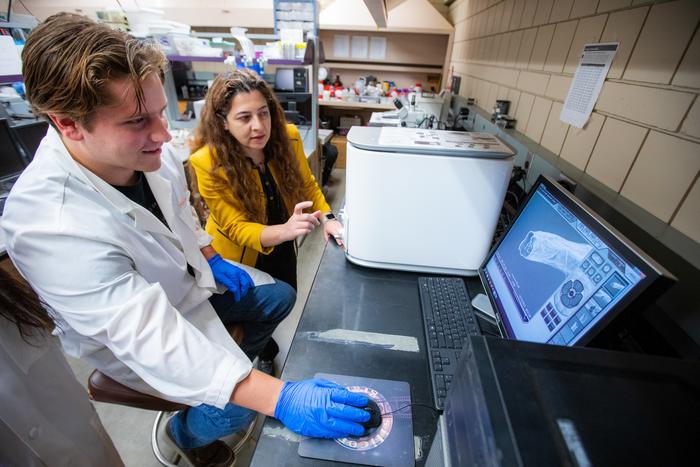New evidence of unmonitored and unreported coal ash spills in a North Carolina lake highlights the risk of similar spills at coal ash storage sites nationwide

Credit: Avner Vengosh, Duke University
DURHAM, N.C. — Coal ash solids found in sediments collected from Sutton Lake in 2015 and 2018 suggest the eastern North Carolina lake has been contaminated by multiple coal ash spills, most of them apparently unmonitored and unreported until now.
“Our results clearly indicate the presence of coal ash at the bottom of Sutton Lake and suggest there have been multiple coal ash spills into the lake from adjacent coal ash storage facilities after, and even before, floodwaters from Hurricane Florence caused major flooding in 2018,” said Avner Vengosh, professor of geochemistry and water quality at Duke University’s Nicholas School of the Environment, who led the research.
“The levels of coal ash contaminants we detected in Sutton Lake’s sediments, including metals with known environmental impacts, are similar to or higher than what was found in stream sediments contaminated by the 2008 Tennessee Valley Authority coal ash spill in Kingston, Tennessee, or the 2014 Dan River spill here in North Carolina,” Vengosh said.
Sutton Lake served as an impoundment for a Duke Energy coal-fired power plant from the 1970s until the plant was retired and replaced with a natural gas-powered plant in 2013. It is located on the Cape Fear River about 11 miles upstream from the city of Wilmington, and is now widely used for recreational boating and fishing. In September 2018, floodwaters from Hurricane Florence inundated the lake and an adjacent coal ash landfill before flowing back into the Cape Fear.
Coal ash has long been known to contain high levels of toxic and carcinogenic elements that can pose ecological and human health risks if they leak into the environment. Power plants in the United States generate about 100 million tons of the ash a year. About half of it is stored in landfills or impoundments, in most cases adjacent to waterways.
“What’s happened at Sutton Lake highlights the risk of large-scale unmonitored spills occurring at coal ash storage sites nationwide. This is particularly true in the Southeast where we see many major land-falling tropical storms and have a large number of coal ash impoundments located in areas vulnerable to flooding,” Vengosh said.
While several lines of evidence suggest the coal ash solids found in Sutton Lake originate from multiple spills, further analysis will be needed to determine the timeline of these events and if similar unmonitored spills have also happened in other lakes near coal ash ponds in North Carolina, Vengosh said.
The spills could have been caused by floods, he noted, but other causes such as accidental release or past dumping practices cannot be ruled out
He and his colleagues published their peer-reviewed study May 24 in the journal Science of the Total Environment.
To do the study, they conducted four independent sets of laboratory tests on bottom sediments collected in October 2018 from seven sites in Sutton Lake and three sites in the adjacent Cape Fear River. They also analyzed three sediment samples collected from Sutton Lake in 2015 and three more collected that same year from nearby Lake Waccamaw, which has never served as a coal ash impoundment.
The researchers analyzed each sample using four different methods for detecting and measuring the possible presence of coal ash solids — magnetic susceptibility, visual observation of microscopic coal ash particles, trace element distributions, and strontium isotope ratios.
The tests revealed high levels of coal ash solids mixed with natural sediments in the samples collected from Sutton Lake in both 2018 and 2015.
Among the contaminants detected were many metals — including arsenic, selenium and thalium, once used as rat poison — that have toxic impacts at elevated levels. The metals are naturally found in coal and are enriched in coal-ash residuals when the coal is burned.
Past studies by Vengosh’s lab have shown that some of these metals, such as arsenic, can be released from coal ash solids into water trapped between grains of sediment at the lake’s bottom, where they build up and, over time, bioaccumulate up the local food web. A 2017 study by Duke University Ph.D. student Jessica Brandt revealed that 85% of all fish tissue samples collected from Sutton Lake still contained selenium at levels that exceeded Environmental Protection Agency standards four years after the coal-fired power plant there was retired. Another study showed that strontium isotope ratios in the inner ears of fish from Sutton Lake now mirror the ratios found in coal ash.
“A coal ash spill is not a one-time contamination,” Vengosh said. “It builds up a legacy in the environment. Even if you close the site, the legacy and threat remain, as our research has revealed at Sutton Lake and other coal ash spill sites such as Kingston, Tennessee. Collectively, these findings imply that the distribution and impact of coal ash in the environment is far larger than previously thought.”
###
The new study was supported by Duke’s Nicholas School of the Environment. No external funding was sought.
Vengosh collaborated with Ellen Cowan, professor of geological and environmental sciences at Appalachian State University, on the study. His other coauthors were Rachel Coyte, Andrew Kondash, Zhen Wang, Jessica Brandt and Gary Dwyer, all of Duke.
CITATION: “Evidence for Unmonitored Coal Ash Spills in Sutton Lake, North Carolina: Implications for Contamination of Lake Ecosystems,” Avner Vengosh, Ellen A. Cowan, Rachel M. Coyte, Andrew J. Kondash, Zhen Wang, Jessica E. Brandt and Gary S. Dwyer; Science of the Total Environment, May 24, 2019. DOI: 10.1016/j.scitotenv.2019.05.188
Media Contact
Tim Lucas
[email protected]
Original Source
https:/
Related Journal Article
http://dx.





